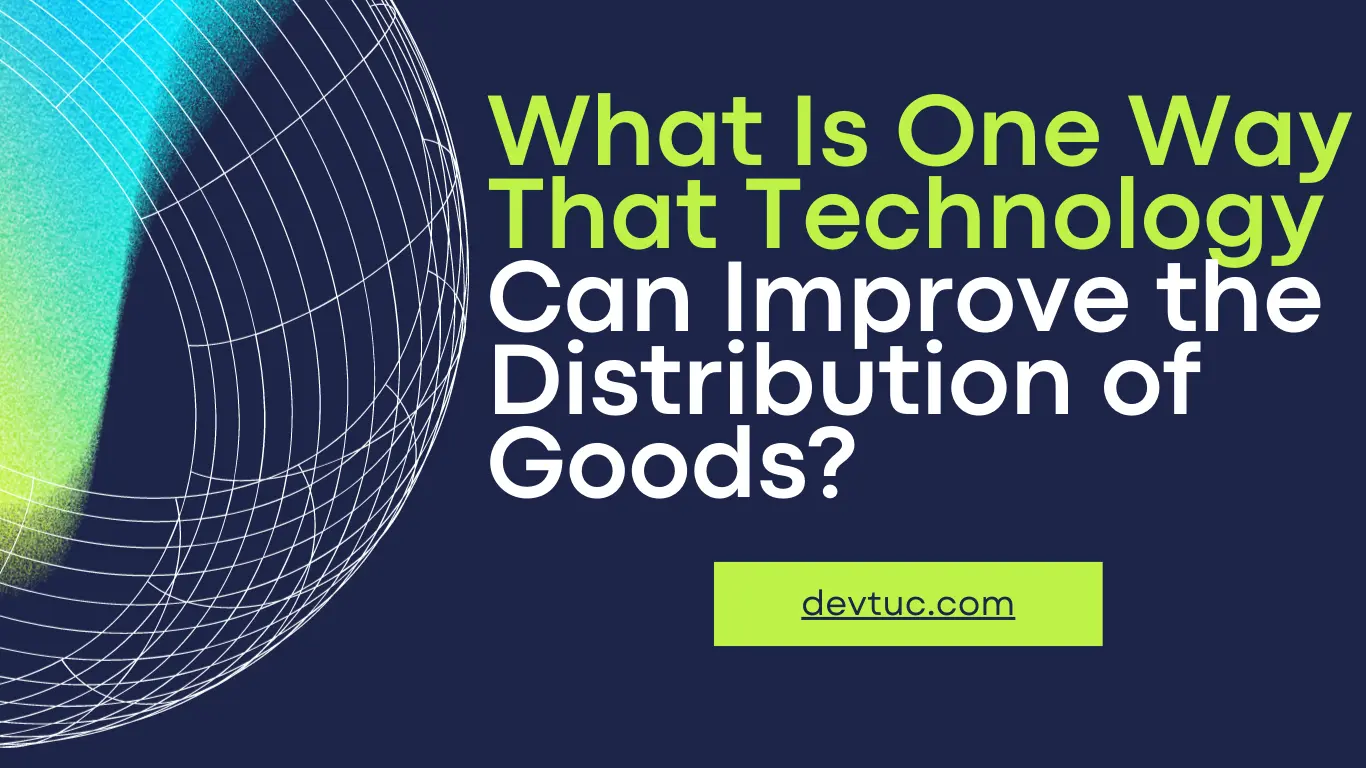Technology is transforming every aspect of our lives, including how goods are distributed around the world. As businesses strive to deliver products faster and more efficiently, the role of technology in distribution has become increasingly crucial. But what is one way that technology can improve the distribution of goods? The answer lies in automation. Automation is a powerful tool that can revolutionize how goods are distributed, making the entire process faster, more accurate, and cost-effective. In this article, we’ll explore how automation can significantly enhance the distribution of goods.
The Role of “What is one way that technology can improve the distribution of goods?”
Technology has always been a key driver in the evolution of distribution methods. From the invention of the wheel to modern-day drones, technological advancements have continuously shaped how goods are moved from one place to another. Today, automation stands out as a game-changer in the distribution industry.
Automation: The Game-Changer in Distribution
Automation refers to the use of technology to perform tasks with minimal human intervention. In the context of distribution, automation can streamline processes such as sorting, packing, and shipping goods. By reducing the need for manual labor, automation not only speeds up the distribution process but also minimizes errors, leading to a more efficient supply chain.
Benefits of what is one way that technology can improve the distribution of goods?
- Speed:
Automation can significantly speed up the distribution process by automating repetitive tasks.
- Accuracy:
Automated systems are less prone to errors, ensuring that goods are sorted and packed correctly.
- Cost-Efficiency:
By reducing the need for manual labor, automation can lower operational costs.
How “what is one way that technology can improve the distribution of goods?” Efficiency
Automation can improve the distribution of goods in several ways. Let’s dive into some specific areas where automation can make a difference.
1. Automated Warehousing
Warehousing is a critical part of the distribution process. Traditional warehouses rely heavily on manual labor for tasks such as picking, packing, and inventory management. However, with the advent of automation, these tasks can now be performed by machines.
- Robotic Picking Systems:
Robots can be used to pick items from shelves and pack them for shipment. These systems are faster and more accurate than human workers, reducing the time it takes to prepare goods for distribution.
- Automated Inventory Management:
Automated systems can track inventory levels in real-time, ensuring that goods are always in stock and ready for distribution.
2. Smart Transportation
Transportation is another area where automation can improve the distribution of goods. Smart transportation systems use technology to optimize routes, reduce fuel consumption, and ensure timely deliveries.
- Autonomous Vehicles:
Self-driving trucks and drones can be used to transport goods, reducing the need for human drivers and allowing for 24/7 distribution.
- Route Optimization:
Automated systems can analyze traffic patterns and suggest the most efficient routes for delivery, reducing fuel consumption and delivery times.
3. Advanced Sorting Systems
Sorting goods for distribution can be a time-consuming process. Automated sorting systems can handle large volumes of goods quickly and accurately, ensuring that they are delivered to the right location.
- Conveyor Belt Systems:
Conveyor belts equipped with sensors can automatically sort goods based on size, weight, and destination.
- Barcode Scanners:
Automated scanners can read barcodes on packages, ensuring that they are sorted and labeled correctly.
Also, Read NFTRandomize: A Tool for Introducing Randomness in NFT Creation
Real-World Examples of “what is one way that technology can improve the distribution of goods?”
Several companies have already implemented automation in their distribution processes, with impressive results. Let’s take a look at some real-world examples.
Amazon
Amazon is a leader in using automation to improve distribution. The company has invested heavily in robotic systems for its warehouses. These robots pick and pack items, reducing the time it takes to fulfill orders. Amazon’s automated systems have enabled the company to offer same-day delivery in many areas.
Walmart
Walmart has also embraced automation in its distribution centers. The company uses automated systems to track inventory, sort goods, and optimize delivery routes. This has allowed Walmart to reduce operational costs and improve delivery times.

The Future of “what is one way that technology can improve the distribution of goods?”
The future of distribution is likely to be even more automated. As technology continues to evolve, we can expect to see more advanced systems that can handle even more complex tasks. Here are some trends to watch out for.
1. AI-Powered Distribution
Artificial intelligence (AI) is expected to play a significant role in the future of distribution. AI can analyze vast amounts of data to optimize every aspect of the distribution process, from inventory management to delivery routes.
- Predictive Analytics:
The AI can predict demand for goods, ensuring that they are stocked and ready for distribution when needed.
- Machine Learning:
AI systems can learn from past data to improve their performance over time, making the distribution process more efficient.
2. Blockchain for Supply Chain Transparency
Blockchain technology can provide transparency in the supply chain, ensuring that goods are distributed ethically and efficiently.
- Traceability:
The Blockchain can track goods from the point of origin to the final destination, providing a transparent record of the entire distribution process.
- Security:
Blockchain technology can secure data related to distribution, reducing the risk of fraud and ensuring the integrity of the supply chain.
Frequently Asked Questions
1. What is one way that technology can improve the distribution of goods?
One way that technology can improve the distribution of goods is through automation. Automation streamlines processes such as sorting, packing, and shipping, making the distribution process faster, more accurate, and cost-effective.
2. How does automation improve accuracy in distribution?
Automation reduces the likelihood of human error by using machines and software to perform tasks. This ensures that goods are sorted, packed, and shipped correctly.
3. What are the benefits of using autonomous vehicles in distribution?
Autonomous vehicles can operate 24/7, reducing the need for human drivers and ensuring that goods are delivered on time. They also optimize routes, reducing fuel consumption and delivery times.
4. How does AI contribute to the distribution of goods?
AI can optimize every aspect of the distribution process, from predicting demand to optimizing delivery routes. This leads to a more efficient and cost-effective distribution system.
5. What role does blockchain play in the distribution of goods?
Blockchain provides transparency and security in the supply chain, ensuring that goods are distributed ethically and efficiently.
Conclusion
In conclusion, “what is one way that technology can improve the distribution of goods?” so automation is one of the most effective ways that technology can improve the distribution of goods. By streamlining processes, reducing errors, and lowering costs, automation has the potential to revolutionize the distribution industry. As technology continues to evolve, we can expect to see even more innovative solutions that will further enhance the efficiency and effectiveness of distribution. Whether it’s through AI-powered systems, blockchain technology, or autonomous vehicles, the future of distribution is set to be more automated, transparent, and efficient than ever before.
Also, Read How Toledo Finance Can Help You Manage Your Finances?

